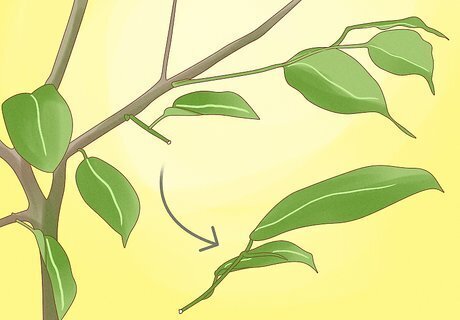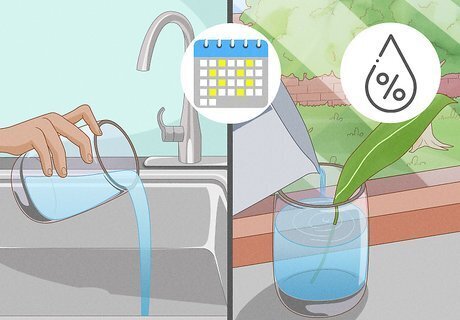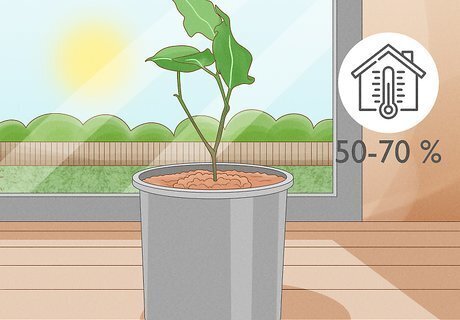
views
Starting a New Plant from a Cutting

Select a healthy sprig for cutting. The easiest way to grow a new ficus is with a cutting from an established plant. The best cutting will be a small sprig that's at least 6 inches (15 cm) long, and with a few leaves on it. You don't want the sprig to be a brand new shoot, but it also shouldn't be too old either. Look for a sprig with no damage and healthy, green leaves.

Remove the cutting below a leaf node. With a pair of sterilized garden shears or scissors, trim your cutting from the rest of the ficus. Make the cut just below a node, which is where a leaf grows out from the sprig. There will be more rooting hormone below the node, which will help to ensure a successful propagation. Be very careful with the sap that comes from the ficus. It can cause a rash if you get it on your skin.

Trim back the branch on the plant. After you remove your cutting, trim the sprig that remains on the main ficus to just above the next leaf node. This will help the plant to heal faster.

Remove the bottom leaves from the cutting. With the scissors or garden shears, trim off all the leaves from the bottom of the cutting. You can leave one top leaf intact, but remove all other foliage so the plan can concentrate its energy on rooting. The cutting will quickly dry out and die if you don't remove most of the leaves, because the plant will put too much energy into keeping the leaves alive.

Transfer the cutting to a glass of fresh water. Fill a tall glass with fresh, warm water. Place the cutting into the glass so the stem is submerged and the leaves are above water. As the cutting sits in the water, it will begin to grow roots.

Give the cutting lots of light and fresh water. Change the water in the glass once or twice a week. Place the glass somewhere warm, bright, and slightly humid. While the cutting is rooting, keep it out of direct sunlight. Filtered light is better for the ficus as it propagates.

Let the cutting root for about three weeks. Two to three weeks will be plenty of time for the new root system to establish itself. When there is a small ball of roots at the bottom of the stem, the cutting is ready to be transplanted to soil.
Transplanting the Cutting

Fill a small pot with potting soil. Find a small, 4-inch (10-cm) pot and fill it halfway with a high-quality, well-draining, and soil-based potting mix. Avoid peat-based potting mixes, as these won't provide the plant with enough stability. High-peat mixes also become compacted over time, and this can cause problems for the root system.

Place the cutting into the soil and cover the roots. Remove the cutting from the water and transfer it to the pot. Make sure the roots are resting against the soil. Hold the cutting upright and add more soil to cover the roots and bottom of the stem. You want to add enough soil to cover the roots and stabilize the stem, but not so much soil that most of the stem will be covered. When you've added the soil, gently tap the pot against a flat surface a few times to help settle the soil around the roots.

Water the transplant. Thoroughly soak the soil with fresh, warm water as soon as the transplant is complete. Ficus plants aren't overly thirsty, but most plants like water after a shock like transplanting. Water the ficus as the soil dries out over the next several weeks.

Leave the ficus somewhere bright. Place the transplanted ficus in a bright and warm location, but keep it out of direct sunlight, especially until it's more established. There should be some new growth at the top of the plant before it's exposed to direct sunlight.
Caring for a Ficus

Find a permanent bright location once it's established. The ideal location for a ficus is somewhere that's very bright but that doesn't get a lot of direct sunlight. The leaves can burn if they're exposed to too much direct sunlight, especially if the room isn't humid enough for them. In winter, a warm and bright bathroom or room with a skylight is ideal for the ficus. In the warmer summer months, you can move the plant outside to a bright balcony or patio, as long as there's lots of afternoon shade.

Water the plant when the soil gets dry. Overwatering can be a big problem for the ficus, because they only need to be watered when the soil gets dry. When the plant is in a growing phase (during spring and summer) water it regularly, but don't keep the soil moist. Allow the top of the soil to dry out between waterings. Overwatering can cause the leaves to curl or turn brown, or cause the leaves to drop. In fall and winter, water the plant less often, and let the soil dry to a depth of a few inches (several centimeters) before watering.

Keep the ficus at room temperature. The ideal temperature for a ficus is between 65 and 75 F (18 and 24 C). The ficus does not like temperature extremes or fluctuations, and it will likely drop its leaves if it's exposed to freezing temperatures. Ideally, the plant should never be exposed to temperatures below 50 F (10 C).

Maintain the right humidity. Because the ficus is native to more tropical climates, it tends to thrive better in slightly humid environments. The ideal humidity for the ficus is between 50 and 70 percent, and anything drier than that could cause the plant to drop its leaves. To increase the humidity, consider installing a portable humidifier near the plant, or misting the plant and the nearby air daily. Because the ficus doesn't like dry air, keep it away from vents, air exchanges, radiators, heaters, and anything else that could cause a draft.

Feed the plant regularly during growing season. Between late spring and early fall, fertilize the ficus every two to four weeks to encourage healthy leaf growth and prevent the leaves from turning yellow. Combine a small amount of liquid fertilizer and water and feed the plant to keep it healthy during growing seasons.

Transplant the ficus every three to four years. The ficus will have to be transplanted to a slightly larger pot every few years as the roots outgrow the current pot. The best time to replant is in early spring. To transplant the ficus: Choose a pot that's one size up (about 2 inches (5 cm) larger in diameter) from the current pot Fill the pot halfway with fresh, well-draining, soil-based potting mix Gently wiggle the ficus loose from its current pot Place the ficus into the new pot Cover the roots and bottom of the stem with more soil Water the plant

Move the ficus as little as possible. The ficus is very sensitive to changes in temperature, humidity, light, and other elements, and even the slightest change could result in a leaf drop. As such, it's best to find an ideal location for the ficus and leave it there. If you do have to move the ficus, or choose to take it outside for the warmer seasons, it may take the plant a few weeks to recover from the move, but it will survive.


















Comments
0 comment